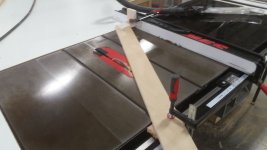Crazyraceguy
Member
- Joined
- Oct 16, 2015
- Messages
- 4,905
One of the guys at work brings me this piece of a 2x4 with a cove kind of scribbled onto the end of it and says "Can you do this?"
I say "Sure, but we can do it on a nicer piece of wood". He says "no need, It's going outside and will get painted anyway".
"Ok, leave it with me, I'll make it happen"
So, at lunchtime today, I set up this little fence rig and go about cutting the cove. Two different people come up to me to see what was going on during lunch and neither of them had ever seen such a set-up? A few others said the same thing later in the day after seeing the part sitting on my bench and asking about it.
I know I have done this more than a few times over the years, but apparently not recently enough for them to have seen it.
I guess it's not an everyday type thing, but I didn't think it was that odd either?
I say "Sure, but we can do it on a nicer piece of wood". He says "no need, It's going outside and will get painted anyway".
"Ok, leave it with me, I'll make it happen"
So, at lunchtime today, I set up this little fence rig and go about cutting the cove. Two different people come up to me to see what was going on during lunch and neither of them had ever seen such a set-up? A few others said the same thing later in the day after seeing the part sitting on my bench and asking about it.
I know I have done this more than a few times over the years, but apparently not recently enough for them to have seen it.
I guess it's not an everyday type thing, but I didn't think it was that odd either?


